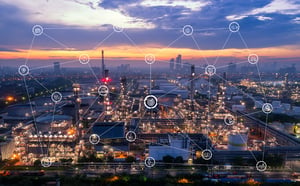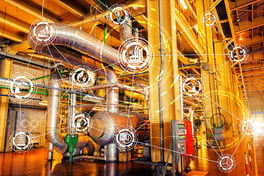The industrial internet of things is the network of industrial devices connected by communication technologies that result in systems that can monitor, collect, exchange, analyze, and deliver data. Simply put, Industrial Internet of Things refers to smart machines and devices a business uses that are connected to the internet and provide real time data and analytics. It brings together machines, analytics, and the people that make it all work. It can be as advanced as a fully automated mass production line that tracks maintenance, productivity and even ordering and shipping information across a huge, multi-layered network. This data can be used to improve existing work practices and business processes as well as creating entirely new ways of doing things.
 Industrial Internet of Things, or IIoT for short, is an extension of the Internet of Things. In a general sense, IIoT is comprised of the hardware, software, and services associated with the management, and analysis of operations and machines. Cloud platforms, sensor connectivity, machine-to-machine communications and data analytics are all part of IIoT and IoT. What separates IIoT from IoT is their type of usage. Internet of Things applications focus on consumer-level devices that are used to boost or improve aspects of a person’s everyday life. Devices such as fitness bands, smart phones, smart homes, and smart cities would all fall under the Internet of Things. Industrial Internet of Things is used to focus on improving the performance of an asset, piece of machinery or an entire business process in an industrial environment.
Industrial Internet of Things, or IIoT for short, is an extension of the Internet of Things. In a general sense, IIoT is comprised of the hardware, software, and services associated with the management, and analysis of operations and machines. Cloud platforms, sensor connectivity, machine-to-machine communications and data analytics are all part of IIoT and IoT. What separates IIoT from IoT is their type of usage. Internet of Things applications focus on consumer-level devices that are used to boost or improve aspects of a person’s everyday life. Devices such as fitness bands, smart phones, smart homes, and smart cities would all fall under the Internet of Things. Industrial Internet of Things is used to focus on improving the performance of an asset, piece of machinery or an entire business process in an industrial environment.
IIoT’s ability to create data that can be turned into adjusted actions provides valuable benefits to a business. Sensors located in production systems, assembly lines, warehouses and vehicles provide data that helps managers monitor how an asset is performing and address issues before they arise. IIoT solutions provide real-time information on the performance of equipment and worker performance to help streamline and improve business processes and workflows. By placing IIoT sensors within products, manufacturers can capture and analyze how customers use their products. This enables them to have insight for future product upgrades and releases.
 Multiple types of applications across a variety of industries can be found making use of the industrial internet of things. Manufacturing companies are making use of monitoring equipment, optimizing their processes, and doing preventative and predictive maintenance on equipment. The transportation industry is investing heavily into IIoT, mainly to equip vehicles with sensors that help schedule maintenance and optimize fuel consumption. The oil and gas industry can use IIoT sensors to collect raw data to help address the fluctuations in demand and pricing. Even the healthcare industry is making use of the Industrial Internet of Things. IIoT is used to help share images with patients and other caregivers, monitoring and troubleshooting problems with equipment, and real- time location systems that can track equipment, dispensation of medicine, and even staff and patients.
Multiple types of applications across a variety of industries can be found making use of the industrial internet of things. Manufacturing companies are making use of monitoring equipment, optimizing their processes, and doing preventative and predictive maintenance on equipment. The transportation industry is investing heavily into IIoT, mainly to equip vehicles with sensors that help schedule maintenance and optimize fuel consumption. The oil and gas industry can use IIoT sensors to collect raw data to help address the fluctuations in demand and pricing. Even the healthcare industry is making use of the Industrial Internet of Things. IIoT is used to help share images with patients and other caregivers, monitoring and troubleshooting problems with equipment, and real- time location systems that can track equipment, dispensation of medicine, and even staff and patients.
In addition to the very valuable benefits of IIoT connectivity, there are some things that require regular follow up. As an example, with IIoT connectivity, there is a greater possibility for security issues. It is important to validate a system regularly to insure that checkpoints are maintained and that the system security is in place. Compatibility can also be a challenge in connected systems. The complexity of a fully connected system can also lead to failures and downtime if not properly maintained and managed. Connectivity has many positive aspects but without proper follow up and management, it can sometimes come with a price.
 The main purpose of IIoT is to gather data more efficiently to allow businesses to make decisions faster and more accurately. Smart machines are faster and more efficient than humans at capturing, analyzing, and communicating data in real time. In an industrial setting, IIoT is key to processes such as predictive maintenance, enhanced field service, energy management and asset tracking. The more connected operations become, the more efficiently and closely results can be monitored and improved for immediate performance enhancements moving forward. With some operational changes and proper management, this connectivity can make a massive difference in the success of any operation.
The main purpose of IIoT is to gather data more efficiently to allow businesses to make decisions faster and more accurately. Smart machines are faster and more efficient than humans at capturing, analyzing, and communicating data in real time. In an industrial setting, IIoT is key to processes such as predictive maintenance, enhanced field service, energy management and asset tracking. The more connected operations become, the more efficiently and closely results can be monitored and improved for immediate performance enhancements moving forward. With some operational changes and proper management, this connectivity can make a massive difference in the success of any operation.
To learn more about Radwell's products and services
For a behind the scenes look at Radwell


